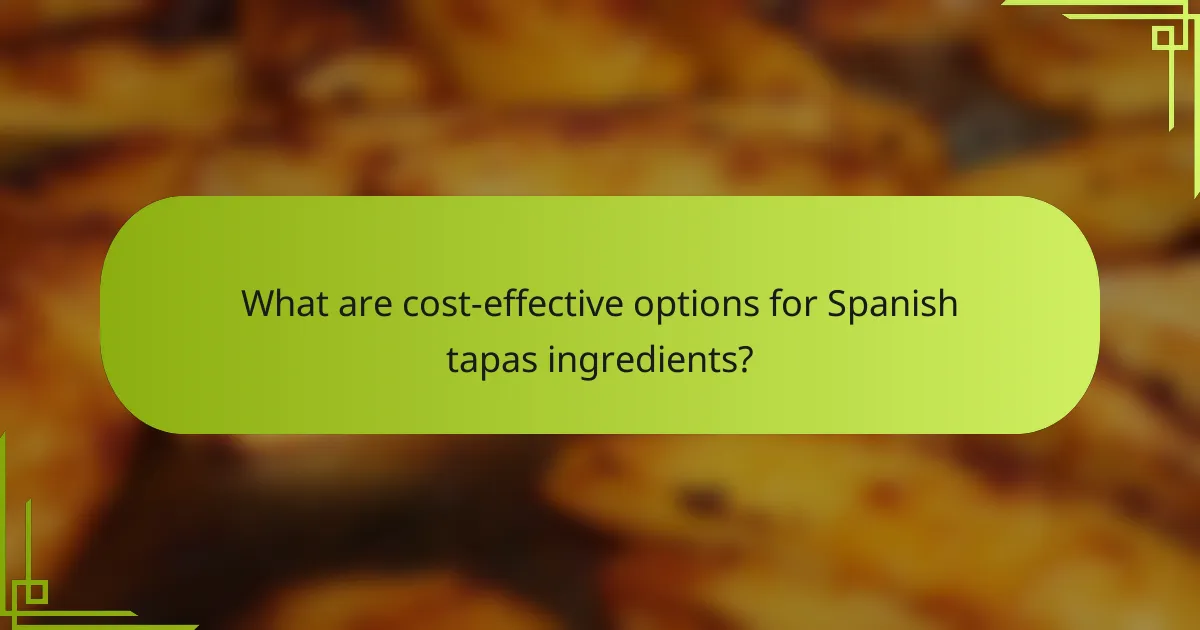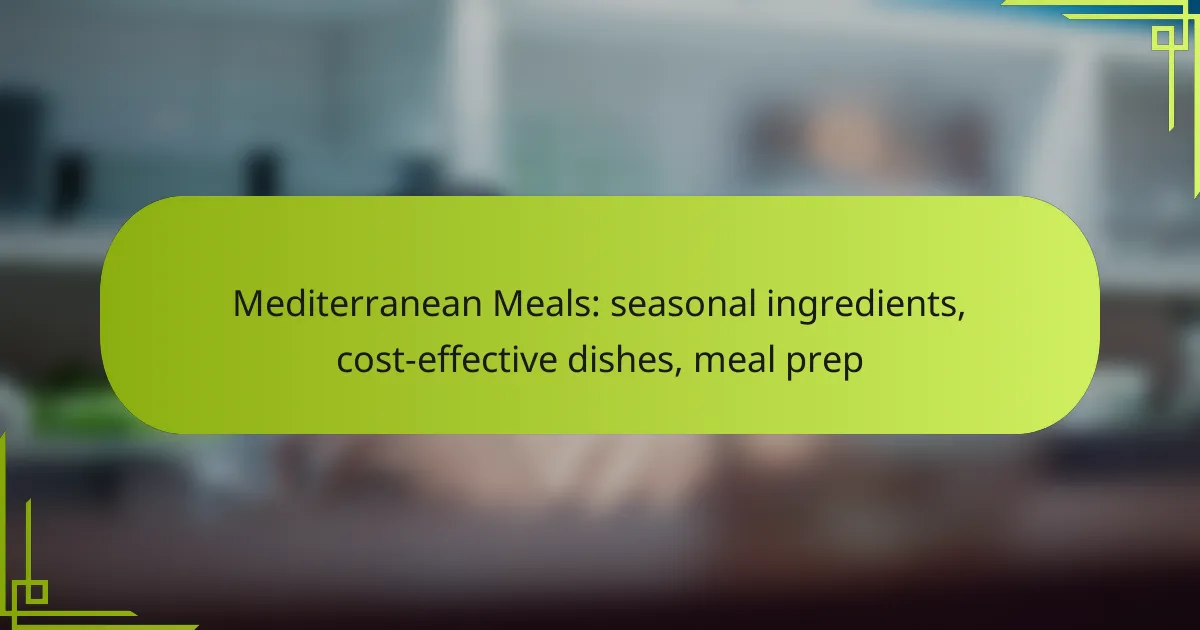Exploring Spanish tapas can be a delightful culinary adventure, especially when sourcing ingredients in the UK. By utilizing local markets and online retailers, you can find fresh produce and specialty items while keeping costs manageable through seasonal selections and smart substitutions. Thoughtful meal planning will ensure a diverse array of flavors and textures, perfect for sharing in a social setting.

How to source ingredients for Spanish tapas in the UK?
Sourcing ingredients for Spanish tapas in the UK involves finding fresh produce, specialty items, and bulk supplies. Local markets, online retailers, and wholesale suppliers each offer unique advantages for creating authentic dishes.
Local markets for fresh produce
Local markets are excellent for sourcing fresh vegetables, fruits, and herbs essential for tapas. Look for farmers’ markets or street markets in your area, where you can find seasonal produce at competitive prices.
Common items include tomatoes, bell peppers, and garlic, which are staples in many tapas recipes. Visiting these markets also allows you to support local farmers and ensure the freshness of your ingredients.
Online retailers for specialty items
Online retailers offer a wide range of specialty items that may be hard to find locally, such as Spanish cheeses, cured meats, and olives. Websites like Spanish Food Online or La Tienda provide authentic products shipped directly to your door.
When ordering online, consider the shipping costs and delivery times, as these can vary. Look for retailers that offer free shipping on larger orders to save money.
Wholesale suppliers for restaurants
Wholesale suppliers are ideal for sourcing ingredients in bulk, especially if you plan to host gatherings or events featuring tapas. Companies like Bidfood or JJ Food Service cater to both restaurants and individuals, providing a variety of products at lower prices.
When purchasing from wholesalers, check for minimum order quantities and delivery options. This can help you manage costs effectively while ensuring you have enough ingredients for your meals.

What are cost-effective options for Spanish tapas ingredients?
Cost-effective options for Spanish tapas ingredients include using substitutes for traditional items and sourcing seasonal produce. These strategies can help you create delicious tapas while keeping your budget in check.
Budget-friendly substitutes for traditional ingredients
When preparing Spanish tapas, consider using budget-friendly substitutes for traditional ingredients. For example, instead of using high-end cheeses like Manchego, try a more affordable sheep’s milk cheese or even a mild cow’s milk cheese. Similarly, if chorizo is too pricey, you can opt for a less expensive smoked sausage that still offers a rich flavor.
Another common substitute is using canned or frozen vegetables instead of fresh ones. Items like roasted red peppers or artichokes can be found at lower prices in these forms, and they still provide great taste and texture for dishes like patatas bravas or tapas platters.
Seasonal ingredients for cost savings
Utilizing seasonal ingredients is a smart way to save money while preparing Spanish tapas. Seasonal produce is often fresher and more affordable, making it an excellent choice for dishes like gazpacho or escalivada. Check local farmers’ markets or grocery stores for fruits and vegetables that are in season to maximize your savings.
For instance, during summer months, tomatoes, peppers, and zucchini are abundant and inexpensive, allowing you to create vibrant and flavorful tapas. In contrast, winter may offer lower prices on root vegetables and hearty greens, which can be used in warm tapas dishes like tortilla española or sautéed greens.

How to plan meals featuring Spanish tapas?
Planning meals featuring Spanish tapas involves selecting a variety of small dishes that can be enjoyed in a social setting. Focus on balancing flavors, textures, and dietary preferences to create an inviting and satisfying experience for your guests.
Creating a tapas menu for gatherings
When creating a tapas menu, consider including a mix of traditional dishes such as patatas bravas, chorizo al vino, and gambas al ajillo. Aim for around five to seven different tapas to provide variety without overwhelming your guests.
Incorporate seasonal and local ingredients to enhance flavor and freshness. For example, use ripe tomatoes for a pan con tomate or fresh seafood for a seafood paella. This not only supports local farmers but can also reduce costs.
Pairing tapas with wines and beverages
Pairing tapas with the right wines or beverages can elevate the dining experience. Spanish wines like Rioja or Albariño complement many tapas well, while a light beer or a refreshing sangria can also be excellent choices.
Consider the flavor profiles of your tapas when selecting drinks. For instance, spicy dishes pair nicely with sweeter wines, while savory options may go better with dry whites or reds. Offering a small tasting flight can encourage guests to explore different pairings.

What are the best Spanish tapas recipes for beginners?
For beginners, the best Spanish tapas recipes are those that use simple ingredients and require minimal cooking skills. Classic options like patatas bravas, pan con tomate, and tortilla española are both accessible and flavorful, making them ideal starting points.
Simple recipes using common ingredients
Many Spanish tapas can be made with everyday ingredients found in local grocery stores. For example, patatas bravas consist of fried potatoes served with a spicy tomato sauce, while pan con tomate is simply toasted bread topped with ripe tomatoes, olive oil, and salt. These recipes require few steps and are budget-friendly.
Another easy option is tortilla española, a Spanish omelet made with eggs, potatoes, and onions. This dish is versatile and can be served warm or cold, making it perfect for any occasion. Using fresh, high-quality ingredients will enhance the flavors without significantly increasing costs.
Quick tapas for last-minute gatherings
When time is tight, consider preparing quick tapas that can be assembled in minutes. A charcuterie board featuring cured meats, cheeses, olives, and nuts can be put together effortlessly and offers a variety of flavors. Pair it with a simple red wine for an authentic touch.
Another fast option is to make bruschetta with toppings like diced tomatoes, garlic, and basil on toasted bread. This dish is not only quick but also allows for customization based on available ingredients. Keep a few staples on hand, such as canned chickpeas and jarred roasted peppers, to whip up a tasty dish in no time.

How to host a tapas night in London?
Hosting a tapas night in London involves selecting a variety of small dishes that encourage sharing and socializing. Focus on sourcing fresh ingredients from local markets and balancing your menu to cater to diverse tastes and dietary preferences.
Setting up a tapas bar at home
To create a tapas bar at home, designate a space where guests can easily access food and drinks. Arrange a selection of small plates, such as patatas bravas, chorizo, and olives, alongside dips like hummus or romesco. Consider using wooden boards or colorful ceramic dishes to enhance the presentation.
When sourcing ingredients, visit local markets like Borough Market or Camden Market for fresh produce and artisanal products. Aim for a mix of traditional Spanish items and local specialties to keep costs manageable while ensuring quality.
Inviting guests and creating a festive atmosphere
Send out invitations well in advance, encouraging guests to bring their favorite tapas dish or drink to share. This not only lightens your workload but also adds variety to the meal. Use social media or group messaging apps for easy coordination.
To create a festive atmosphere, consider adding Spanish music and decorative elements like colorful tablecloths or fairy lights. Set up a comfortable seating arrangement that encourages conversation, and provide plenty of napkins and utensils for easy dining.

What are the nutritional considerations for Spanish tapas?
Spanish tapas can be nutritious when prepared with attention to ingredient quality and cooking methods. Key considerations include balancing macronutrients, using fresh ingredients, and being mindful of portion sizes to maintain a healthy diet.
Healthier cooking methods for traditional recipes
To make traditional tapas healthier, consider using methods such as grilling, steaming, or baking instead of frying. For example, instead of deep-frying patatas bravas, roast the potatoes with a drizzle of olive oil for a lower-fat option.
Another approach is to incorporate more vegetables into your tapas. Dishes like escalivada, which features roasted peppers and eggplant, can be enhanced with additional seasonal vegetables, providing more fiber and nutrients.
Balancing flavors and nutrition
Balancing flavors while ensuring nutritional value is crucial in tapas preparation. Use herbs and spices to enhance taste without adding excess salt or fat. For instance, fresh parsley, garlic, and smoked paprika can elevate dishes like gambas al ajillo while keeping them healthy.
Additionally, consider portion control by serving smaller amounts of richer dishes alongside larger servings of lighter options. This strategy allows diners to enjoy a variety of flavors without overindulging, promoting a balanced meal experience.

How to adapt Spanish tapas for dietary restrictions?
Adapting Spanish tapas for dietary restrictions involves substituting or omitting certain ingredients while maintaining flavor and authenticity. Consider the specific dietary needs, such as gluten-free or vegan, to create enjoyable and inclusive dishes.
Gluten-free tapas options
For gluten-free tapas, focus on naturally gluten-free ingredients like vegetables, meats, and certain cheeses. Dishes such as patatas bravas (spicy potatoes) and gambas al ajillo (garlic shrimp) can easily be made gluten-free by ensuring that any sauces or seasonings do not contain gluten.
When sourcing gluten-free options, check labels for hidden gluten in processed foods. Additionally, consider using gluten-free bread alternatives, such as those made from rice or corn, for dishes like pan con tomate (bread with tomato).
Vegan alternatives for traditional dishes
To create vegan versions of traditional tapas, replace animal-based ingredients with plant-based alternatives. For instance, use chickpeas instead of chorizo in a chickpea stew or substitute dairy cheese with nut-based cheeses in dishes like stuffed peppers.
Incorporate a variety of vegetables, legumes, and grains to enhance flavor and texture. Dishes such as escalivada (roasted vegetables) and olives can be served as is, while ensuring that all sauces and dressings are free from animal products.

What are emerging trends in Spanish tapas dining?
Emerging trends in Spanish tapas dining focus on sustainability, local sourcing, and innovative flavor combinations. Diners increasingly seek authentic experiences that highlight regional ingredients and creative presentations.
Ingredient sourcing for Spanish tapas
Ingredient sourcing for Spanish tapas emphasizes fresh, local produce and traditional Spanish staples. Many chefs are turning to farmers’ markets and local suppliers to ensure quality and sustainability, which enhances flavor and supports the community.
Key ingredients include olives, cured meats, cheeses, and seasonal vegetables. Sourcing these items locally can reduce costs and improve freshness, making them ideal for tapas preparation.
Cost-effective options for tapas
Cost-effective options for tapas involve using affordable yet high-quality ingredients. Consider incorporating seasonal produce and bulk purchasing to lower expenses while maintaining flavor.
For example, using chickpeas for dishes like hummus or patatas bravas can be economical. Additionally, exploring less expensive cuts of meat or utilizing pantry staples can create delicious tapas without breaking the bank.
Meal planning for tapas
Meal planning for tapas requires careful consideration of portion sizes and variety. Aim for a balanced selection of flavors and textures to create an appealing spread.
Start by selecting a few key dishes, such as a meat option, a seafood dish, and a vegetarian choice. Plan for around three to five small plates per person, adjusting based on the occasion and guest preferences. This approach ensures a satisfying dining experience while managing costs effectively.










